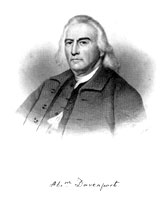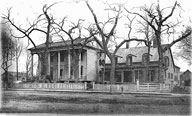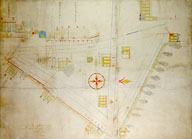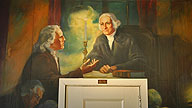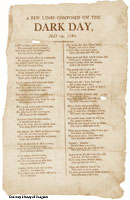| Join | Official Historian | City of Stamford | Blog | About Us | |
| Jewish Historical Society | Civil War Roundtable | Contact Us | |
|
|
|
|
The Stamford Historical Society PresentsPortrait of a Family: Stamford through the Legacy of the Davenports
Abraham Davenport 1715–1789
Born 1715 in Stamford, Connecticut Abraham Davenport was the son of John Davenport, who replaced John Bishop as minister of the Stamford church and Elizabeth (Morris) Maltby, John’s second wife. John Davenport died in 1731 and the next year his sons, Abraham and James were graduated from Yale. The properties of Abraham’s widowed mother needed to be cared for, farmed, rented perhaps and here may have begun his interest in acquiring land. In this New England society both brothers were assigned the first pew in the 1735 Meeting House in recognition of their position in the community. The acquiring of real estate commensurate with the esteemed position in the Meeting House led Abraham to a modest start in his career in public service, as a deacon in the church. He was town surveyor in 1738, tithing man in 1737, twice appointed lister and then Selectman for 31 years. Abraham served both Stamford and the Connecticut legislatures for many years, often during the same terms. Meanwhile, he continued to manage and personally supervise his and his mother’s lands and to buy and sell properties prudently. Without a great deal of formal law training, Davenport was many times appointed judge of the Fairfield County Court, the Maritime Court of Fairfield County and as Stamford’s Judge of Probate. Throughout the American Revolution he served on Governor Jonathan Trumbull’s Council of Safety, “which for all practical purposes ran … [Connecticut] … on a day-to-day basis.” He was both a state and local leader with a gift of forming laws. Abraham’s character was firm, even stern, constant in his dedication to his responsibilities concerning all of community and church life, which at this time were a single entity. Nothing embodies this better than his role during New England’s famous Dark Day—a day where the skies of the Northeast, for no explicable reason remained almost completely dim. Davenport’s resolve during this troubling time is described by Timothy Dwight of Yale in his Travels in New England and New York, published 1822. “The 19th of May, 1780, was a remarkably dark day. Candles were lighted in many houses; the birds were silent and disappeared; and the fowls retired to roost. The legislature of Connecticut was then in session at Hartford. A very general opinion prevailed that the Day of Judgment was at hand. The House of Representatives, being unable to transact their business, adjourned. A proposal to adjourn the Council [Senate or Upper House] was under consideration. When the opinion of Col. Davenport was asked, he answered, ‘I am against an adjournment. The Day of Judgment is either approaching, or it is not. If it is not, there is no cause for an adjournment; if it is, I choose to be found doing my duty. I wish therefore that candles may be brought.” And so the State Senate continued working on legislation by candlelight until later in the afternoon, when the darkness eventually dissipated, permitting sunlight to return. The cause of this strange occurrence has never been conclusively determined by scholars, but the theory of smoke emerging from a vast forest fire in Canada has been suggested. Over the years Abraham Davenport’s example of calmness and fortitude during a period of uncertainty and darkness has inspired many on local, state and national levels of public life. In 1868, John Greenleaf Whittier, the noted New England poet, commemorated this unusual phenomenon in a poem titled Abraham Davenport, published in his book Tent On The Beach. In November of 1934, during the very depths of the Great Depression, a mural depicting Abraham Davenport standing before the Governor Trumbull on the Dark Day was dedicated. Painted by Delos Palmer under a commission from the W. P. A., it hung in the City Courtroom, Old Town Hall. At the dedication ceremony Judge Charles Davenport Lockwood stated that it “should be an inspiration and a lesson during these days of hard times.” In his 1960 campaign for President of the United States, Massachusetts Senator John F. Kennedy referred to Abraham Davenport and the Dark Day in several speeches. After citing Dwight and Whittier he concluded by saying, “I hope in a dark and uncertain period in our own country that we, too, may bring candles to help light our country’s way.” The Dark Day’s two hundredth anniversary did not go by unnoticed. On February 27, 1980, a commemorative ceremony was held at Hartford in the Connecticut House of Representatives chamber. The curtains were ordered drawn before the session began. Then House speaker Ernest N. Abate of Stamford proceeded to read Whittier’s famous poem followed by a brief biography of Davenport. As the speaker began, the chamber’s lights were gradually dimmed, until the concluding remarks were made in almost total darkness; upon which illumination was restored. In attendance were a number of individuals from Stamford including J. Robert Bromley, Esq., author of a biography of Abraham Davenport and Dr. Estelle F. Feinstein, Professor of Urban History, University of Connecticut – Stamford, author of two histories of Stamford. Death indeed found Davenport one day in 1789 while he was doing his duty, presiding at the Court of Common Pleas in Danbury. He was interred in the Northfield burying ground which he bequeathed to the church along with 200 pounds for the support of its minister. His name for firmness in the work of his hometown, state and country was not his only legacy. Timothy Dwight wrote of his kindness, hospitality to strangers, generosity to those in need, and care for sick soldiers during the war of the Revolution. Farmer, attorney, judge, politician but first of all a patriot, Abraham Davenport served as an exemplary figure in 18th century Connecticut. Some of the positions Abraham Davenport held during his lifetime:Stamford Representative to the Connecticut General Assembly, 1759-1766 On display in the exhibit is a digital reproduction of a Ralph Earl painting of Abraham Davenport which we cannot show here due to copyright restrictions.Yale University Art Gallery Abraham Davenport sat for this portrait just a year before his death in 1789. Portraitist of prominent New Englanders, Ralph Earl became acquainted with Davenport after his release from debtors’ prison through his court-appointed guardian, Doctor Mason Fitch Cogswell. Doctor Cogswell, stationed in Stamford during the Revolutionary War, studied medicine with his brother, James, an Army surgeon. While in Stamford, James married Elizabeth Huntington Davenport, daughter of Abraham and his wife, Elizabeth. This portrait of Abraham Davenport exemplifies the style Earl employed upon his arrival in Connecticut in 1788, the year of his release from prison. Earl loved to use bright colors, as can be seen by the green cloth and his stock red chair. The use of a green cloth on a writing table or desk symbolizes the law, based on the tradition in English law that a document was not legal unless signed on a green cloth. The cloth in the painting was probably a fabric called “baize,” a thin, napped woolen cloth used in the 18th and 19th centuries. It is quite different in texture from modern-day felt and is still available as a reproduction. |
||
|
|
